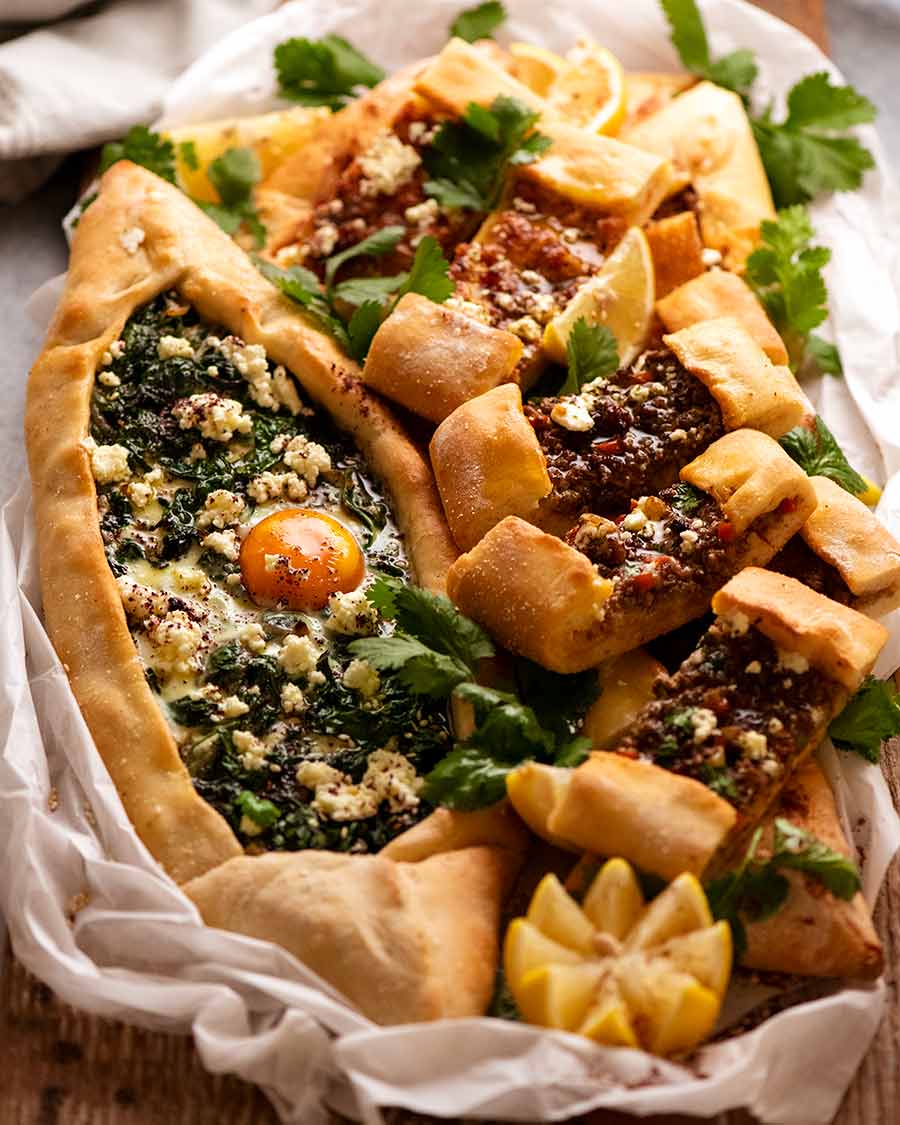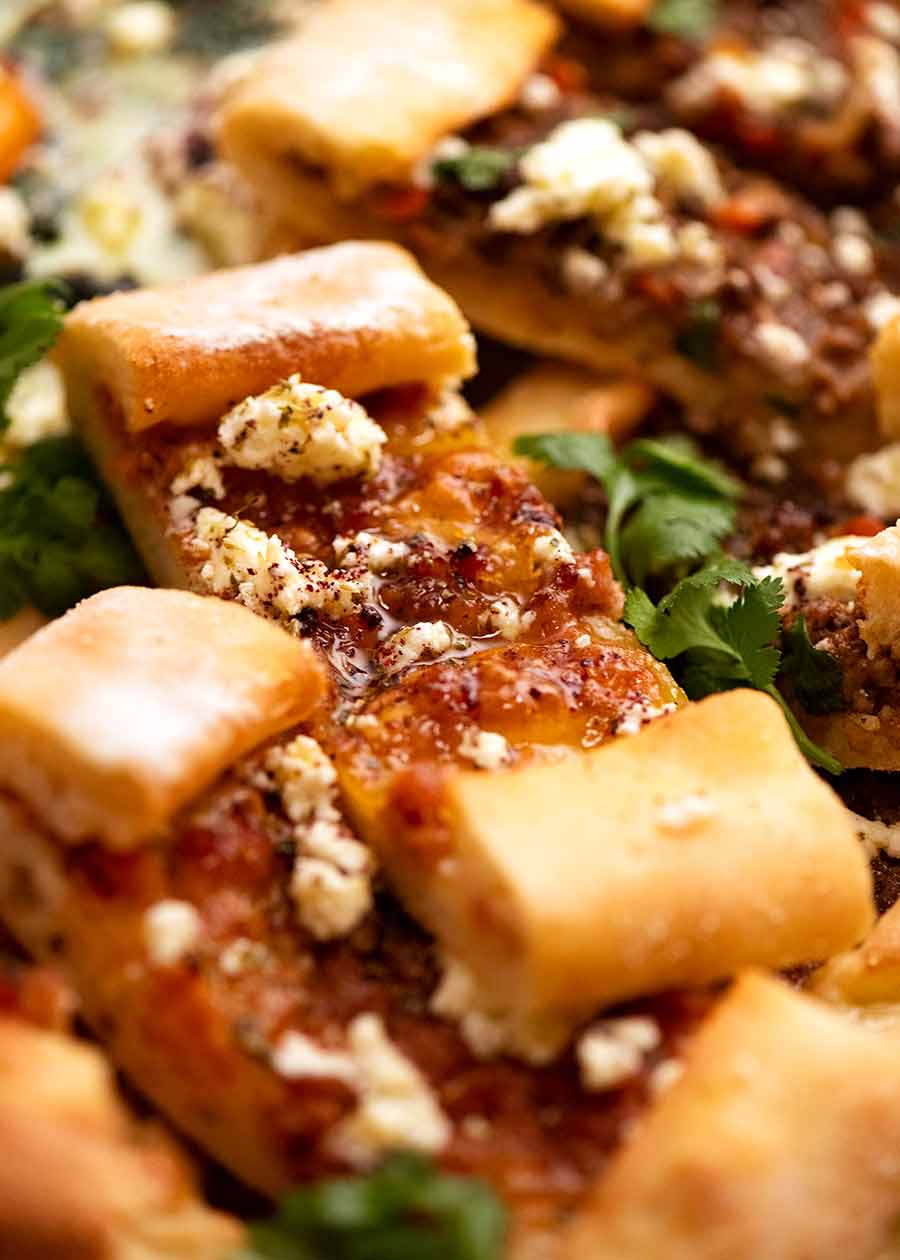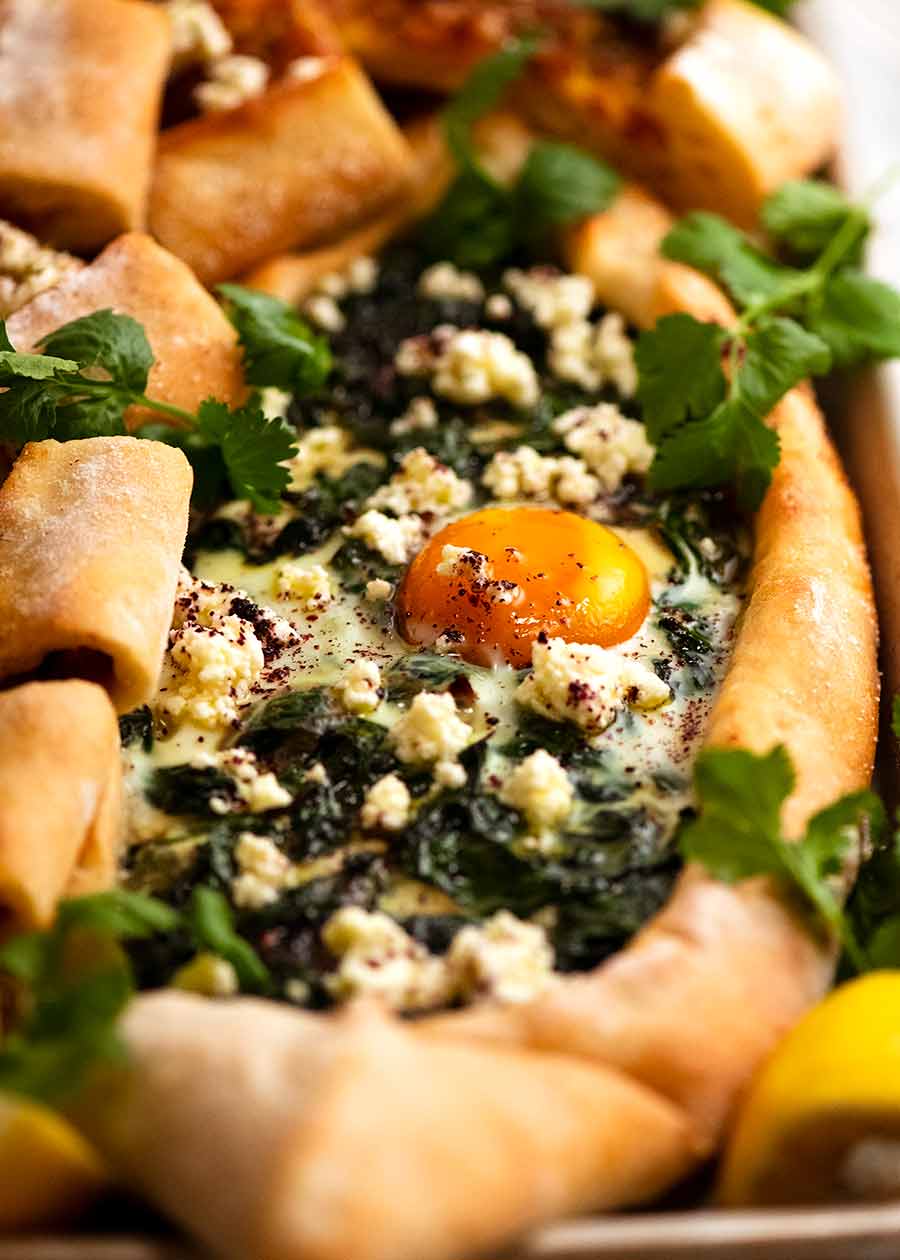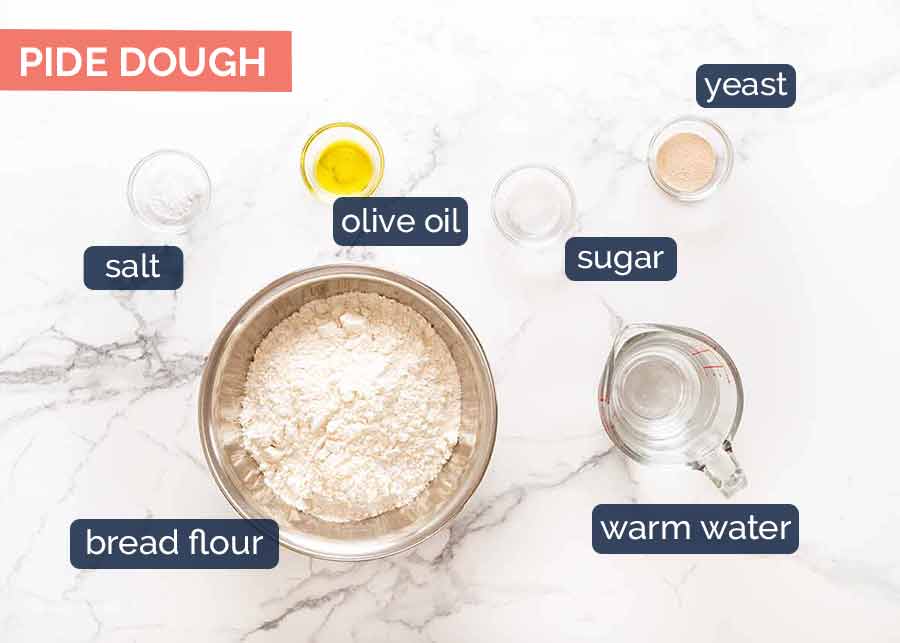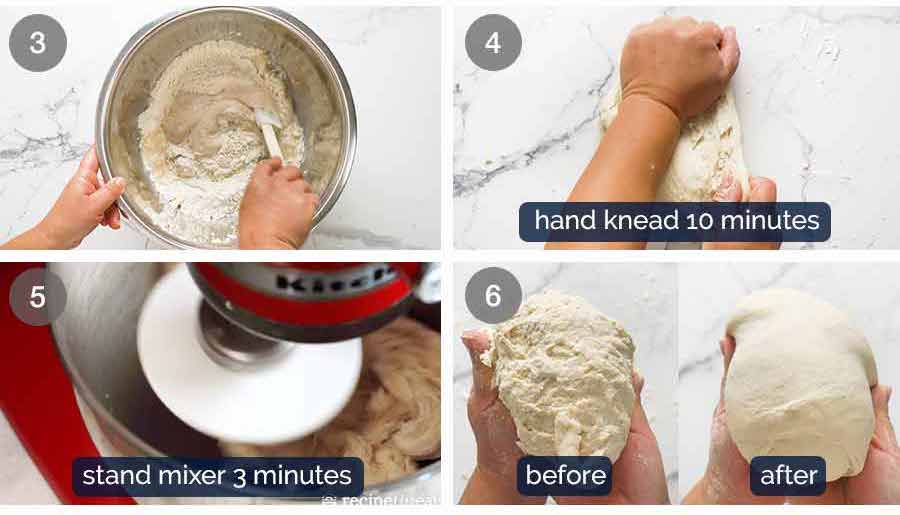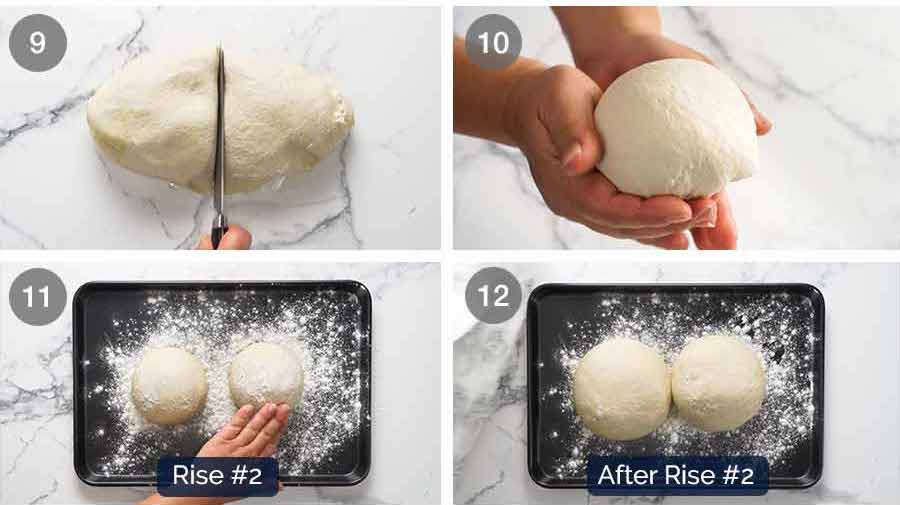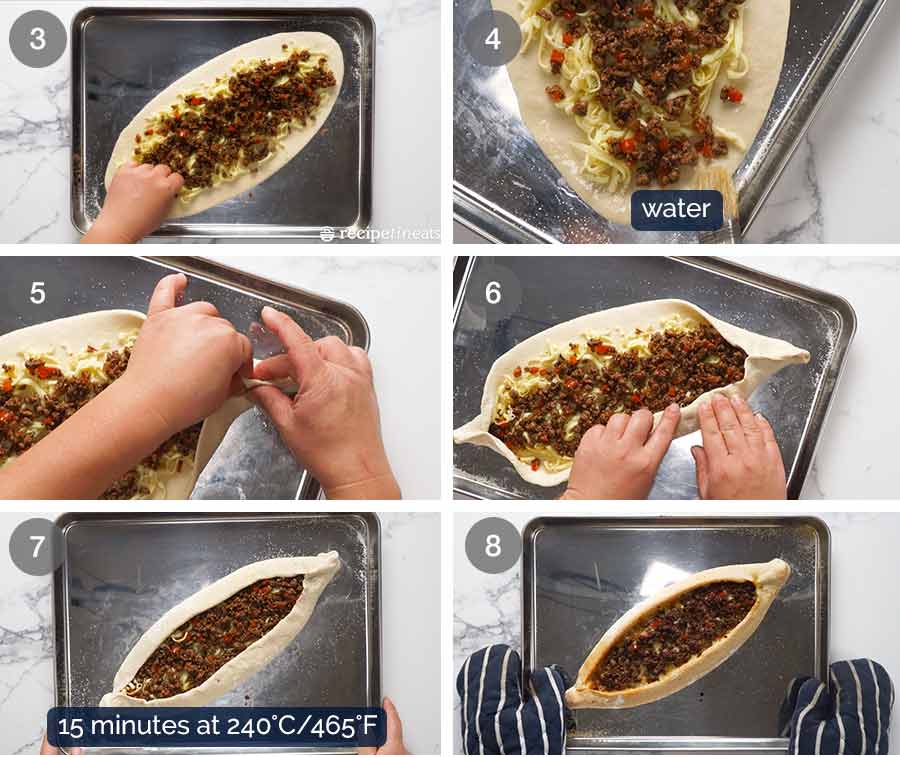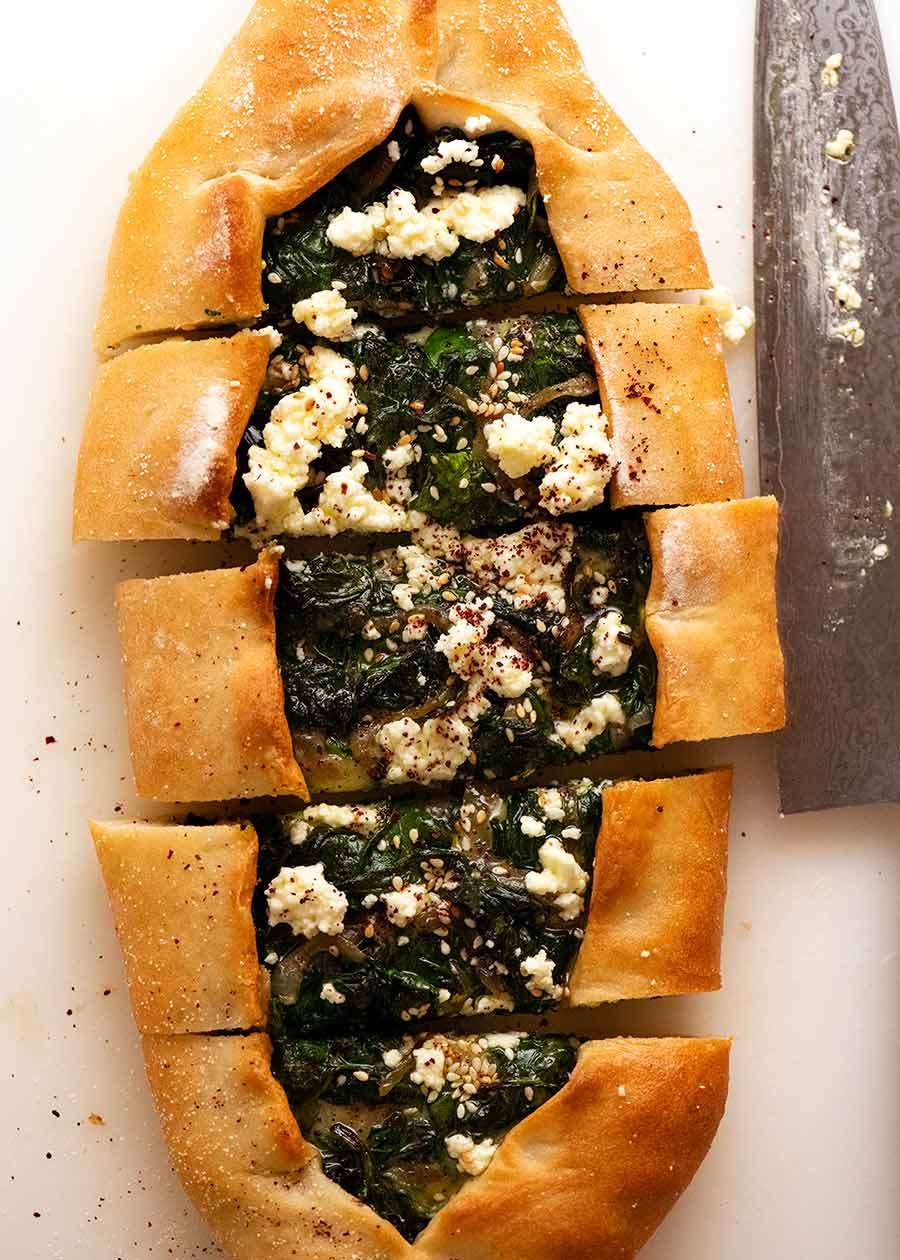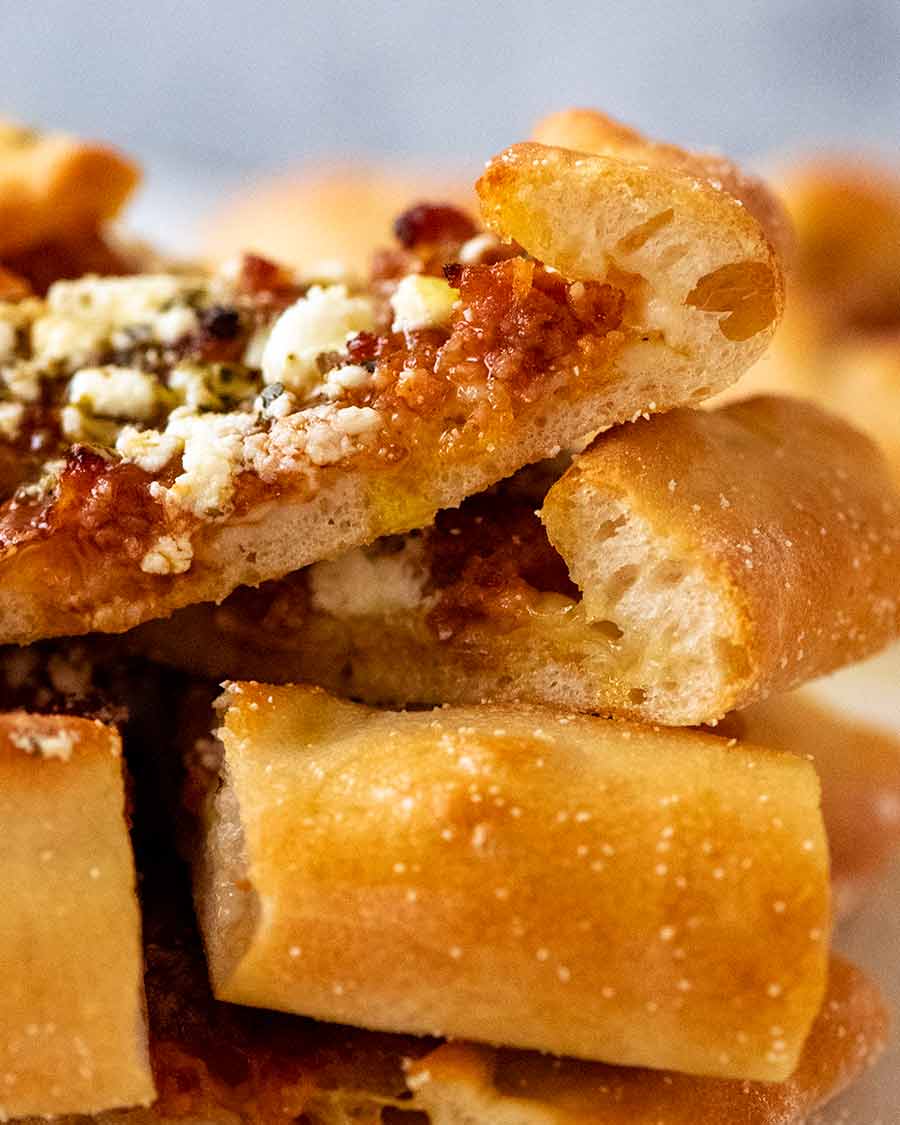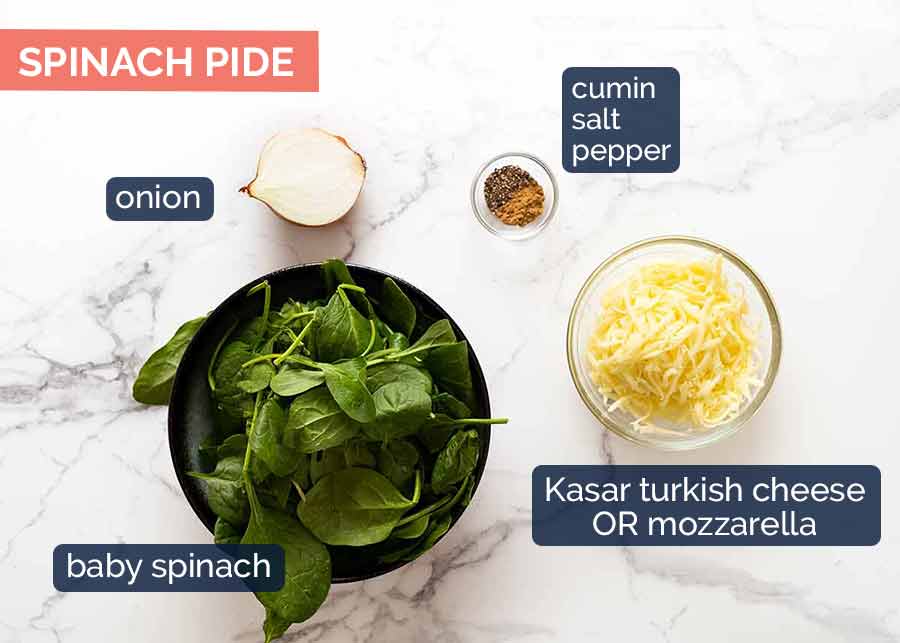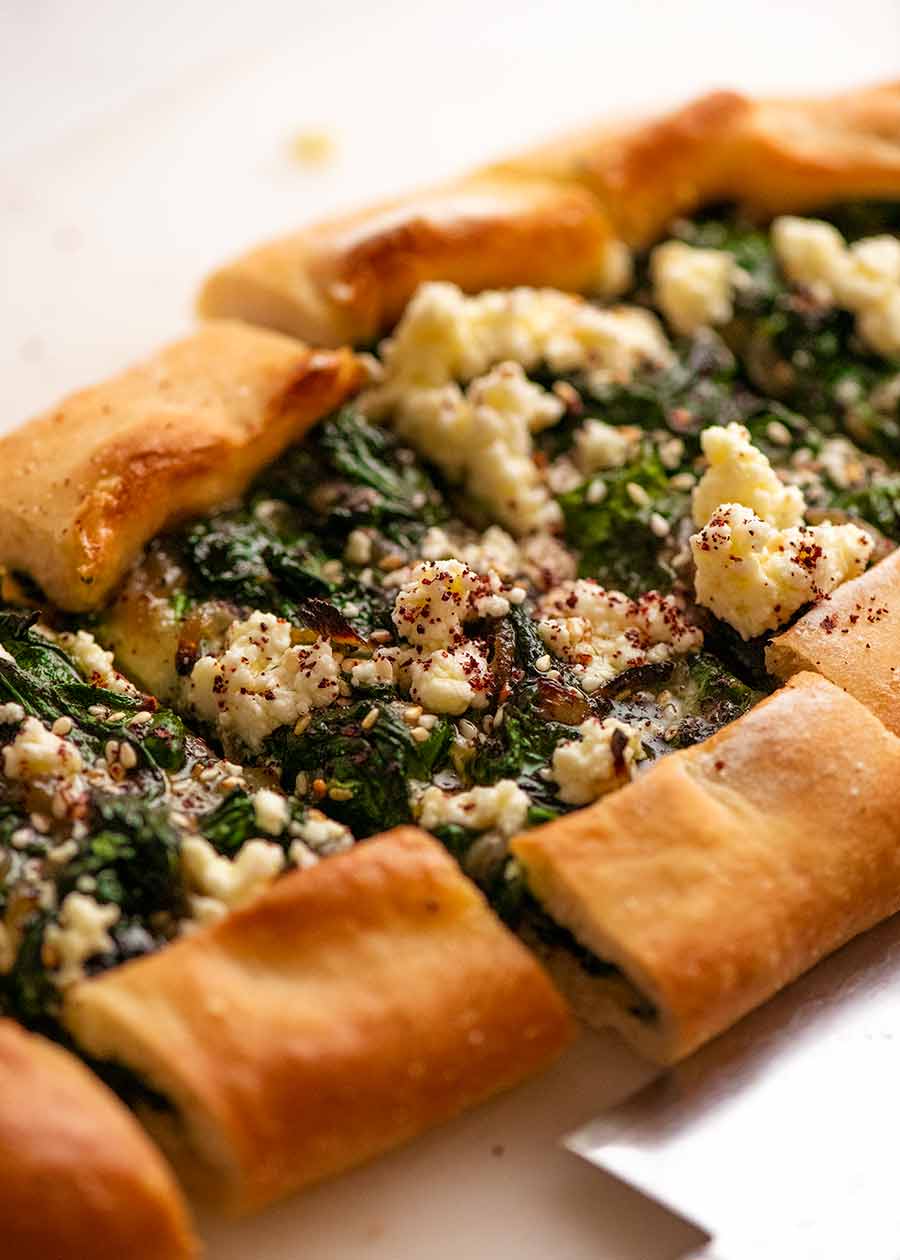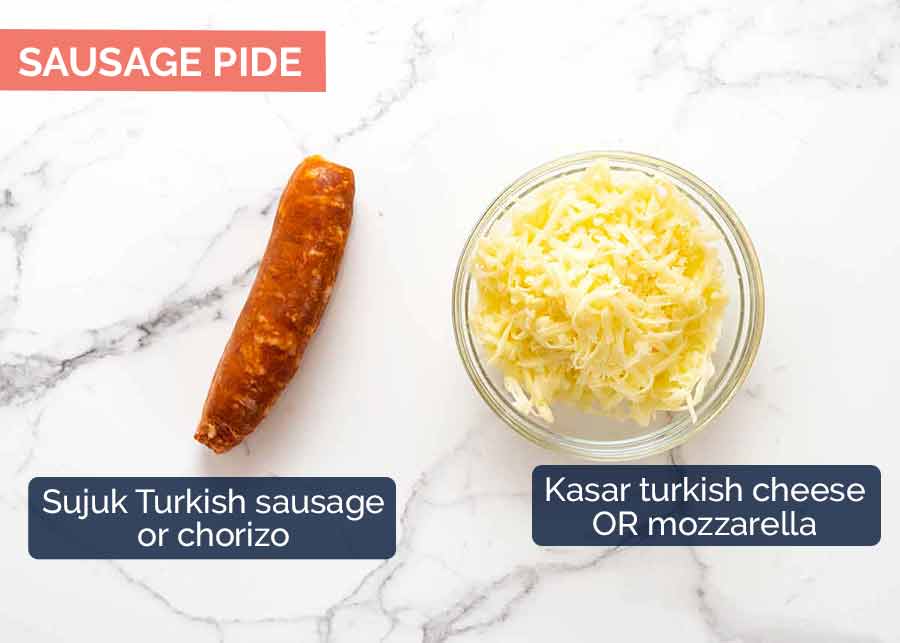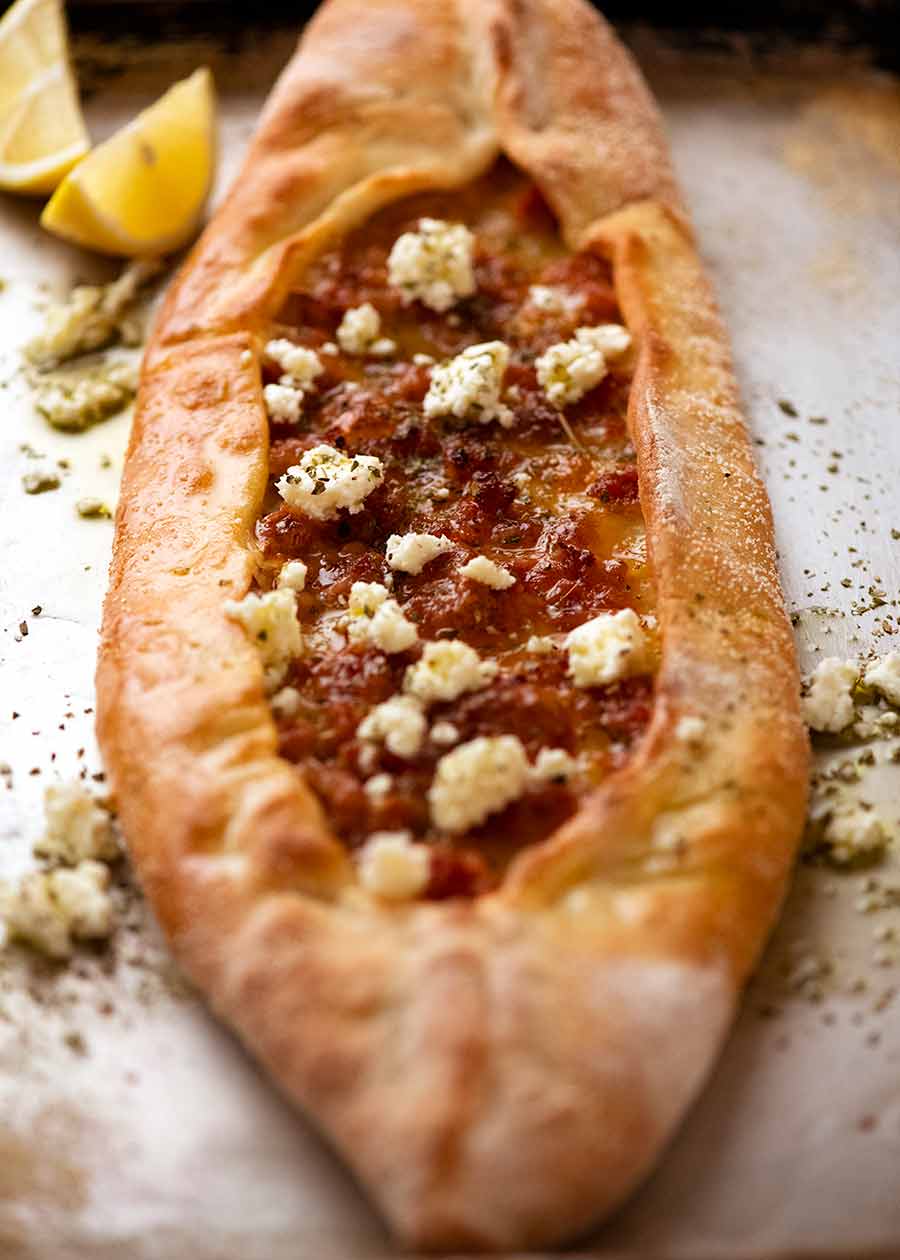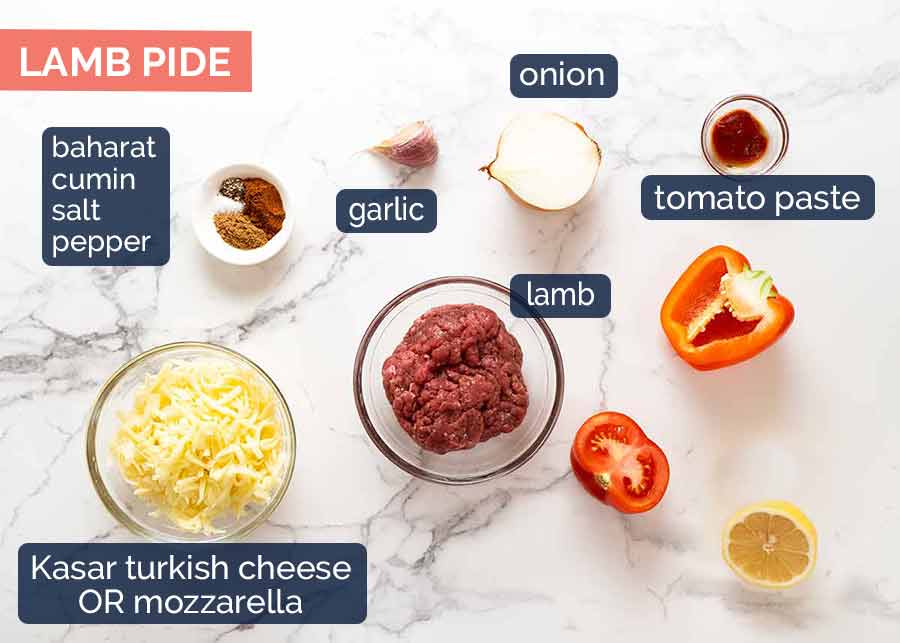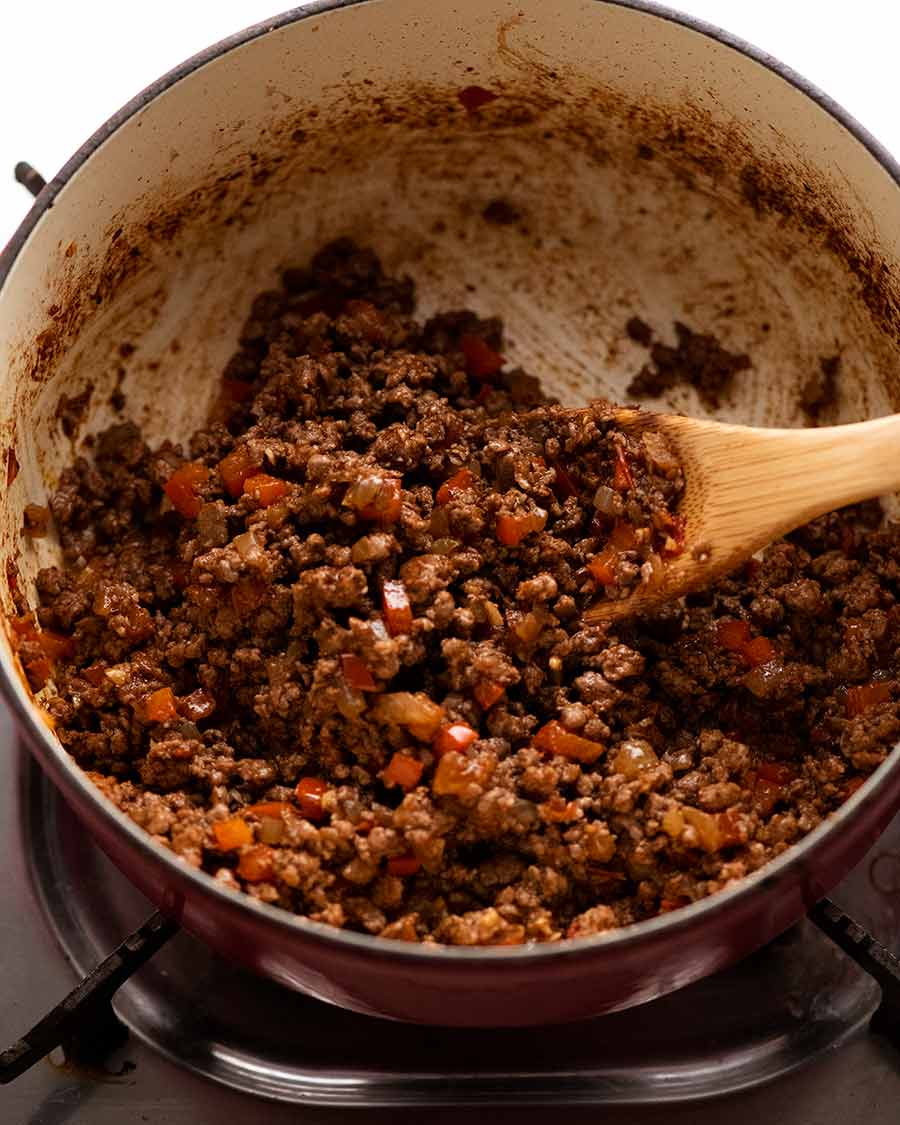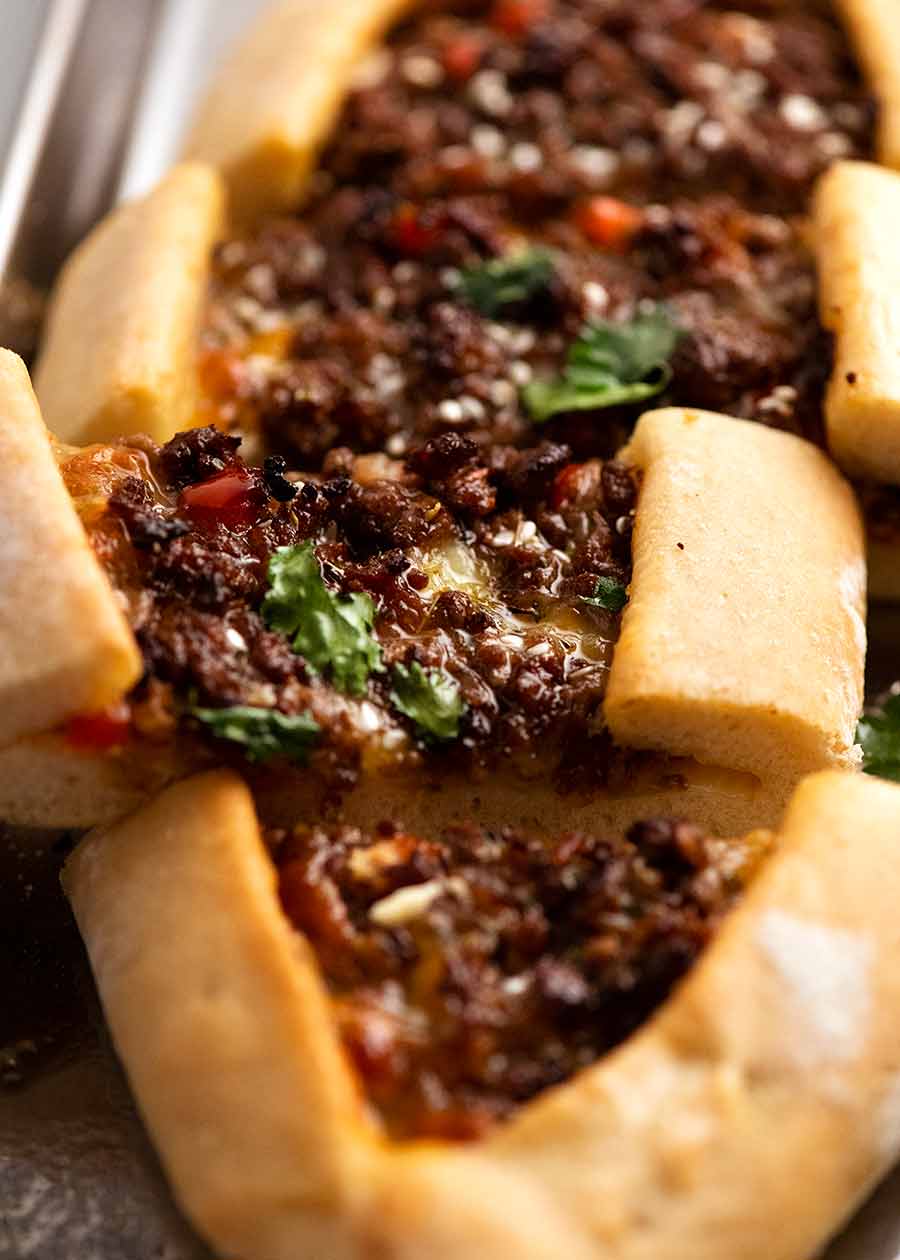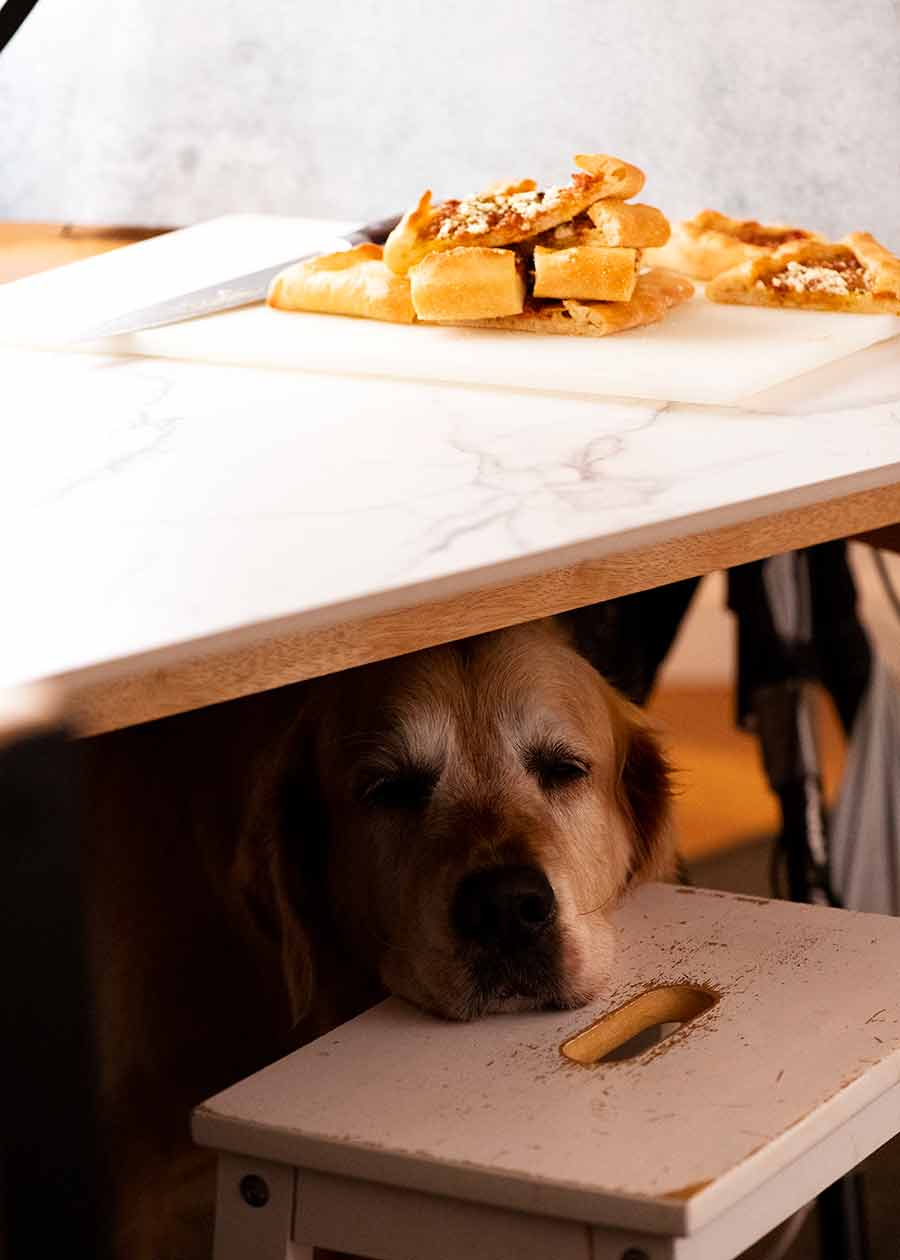Pide
Turkish Pide has been my Secret Food Shame* for as long as I can remember. Not authentic, freshly made Pide crafted lovingly by the hands of someone’s Turkish grandma. I’m talking about the greasy, low-rent versions sold from hot glass cabinets at late night takeaway shops, filled with cheap cheese and piles of meat shaved from giant Doner Kebab punching bags turning lazily on vertical rotisseries. It’s a bit wrong, I know, but I cannot help myself. I have always had a soft spot for bad takeaway Pide. What can I say? When you’re nursing battle wounds from a bad week at work, cheese + bread + tasty toppings will do it every every time! But like all things, there’s a time and place. Pide can be trash food but it can also be incredible, going toe-to-toe with the best artisan Italian pizzas. Made totally from scratch like today’s recipe, it’s apples and oranges to the takeaway junk – even a chronic takeaway Pide tragic like me will admit it!
- Food you secretly love but are ashamed to be caught eating. Think: McDonald’s drive-through. The Dirty Bird (aka KFC). Panda Express. Instant mac and cheese. We are all guilty!
What is Pide, actually?
Originating from Turkey, Pide is an oval-shaped flatbread baked with various combinations of toppings or stuffings. You could say it’s a cousin of Gozleme, only Pide dough is fluffier and more bread-like. Spiced mince meat (Kiymali Pide) is common, as are versions with spinach, and also Turkish beef sausage (sujuk). Pronounced pee-dae, Pide is typically open-faced, though sometimes you also see closed versions. With the latter, the filling is completely sealed within the bread. While both are delicious, the extra flavour you get from the toppings sizzling away in the oven is irresistible to me, so that’s the version I’ve opted for today! Traditionally, Pide is cooked in a stone oven, but this recipe today is for a boring old home oven. 🙂 We will survive!
How to make Turkish Pide
In this section, I’m going to step through how to make Pide, from the dough through to assembly and baking. I’ll also cover how to make each of the topping variations. A content summary: Heads up!: This section is quite long because I walk through each step, including the ingredients for the three topping options. My goal is to provide enough information so even those of you who are not experienced using yeast are armed with all the information you need to make this. You’ve got this! I promise!
Making the doughAssembling the pide
About Kasar Turkish cheese (substitute mozzarella)#1: Spinach topping#2: Turkish sausage (sujuk / sujuk)#3: Spiced lamb (Kiymali Pide)The sprinkled finishes for Pide
(If you’re an old hand at all things baking and don’t need this level of information, just skip to the recipe or recipe video!)
1. Pide dough
Pide dough ingredients
Here’s what goes in the Pide dough:
Flour – Bread flour produces a slightly fluffier, softer bread than using plain / all-purpose flour. It also has a slightly better chew, a key characteristic that distinguishes bread from, say, cake which has a tender, crumbly crumb by contrast.The difference between bread flour and plain flour however is actually quite marginal, so I’m not going to insist on it as strongly as I do in other recipes where using bread flour really makes a difference (eg. like, say, in our favourite Crusty Artisan Bread). So for this recipe, I recommend using bread flour only if you have it. If you don’t, I wouldn’t make a special trip to the supermarket because this is excellent made with all-purpose / plain flour too;Yeast – Instant / rapid-rise yeast is called for here. The recipe also works with standard active / dry yeast, but we discovered during the naan recipe project (or odyssey rather!) that flatbreads are slightly fluffier and softer using instant yeast;Sugar – The yeast feeds on sugar to activate, bloom and do its yeasty thing. Without sugar, the mixture won’t become foamy nor will the dough rise as much; andWarm water – The other things yeast needs to get it alive and kicking. You do not want scorching hot water as this will kill the yeast. Nor do you want too cold, as this slows the yeast activation significantly, and the mixture will never become foamy which means the dough won’t rise. Blood temperature is about right.
How to make Pide Dough
BLOOM THE YEAST
First step: Let’s get the yeast activated and ready to work its magic on our dough. The difference between bread flour and plain flour however is actually quite marginal, so I’m not going to insist on it as strongly as I do in other recipes where using bread flour really makes a difference (eg. like, say, in our favourite Crusty Artisan Bread). So for this recipe, I recommend using bread flour only if you have it. If you don’t, I wouldn’t make a special trip to the supermarket because this is excellent made with all-purpose / plain flour too;
MAKE THE DOUGH
The dough can be made either by hand or using a stand mixer. But when creating my naan recipe, we found that blooming instant yeast in a warm water and sugar solution first makes flatbreads fluffier and softer. It’s also an excellent safety test to ensure your yeast is still alive. Foamy yeast in water = alive, no foam = dead yeast! That’s right, dried yeast stored in a jar eventually dies (that’s what the expiry means – but actually it starts to degrade well before that). Nothing is worse than discovering your yeast is dead by taking out a cooked bread loaf from the oven that’s rock hard and flat!
RISE DOUGH 1 TO 1.5 HOURS – LET IT DOUBLE IN SIZE
Rise #2
Assembling and baking the Pide
Dough done, now it’s time to assemble! I walk through the making of each of the toppings further below. Cover with cling wrap and put the bowl somewhere warm to let it proof – about 1 – 1.5 hours, until it has doubled in volume. When seeking a warm place to let the dough rise, remember that the warmer it is, the faster it will rise. Do not put it in direct sunlight, it’s too strong and will dry out the dough. CHEEKY TIP: Use your dryer! Run it for a few minutes to warm it up, then place the dough in and close the door. It’s a draught-free, warm and cosy environment your dough will love!
Roll out the dough
Assembling the Pide
Here’s a close up photo of inside the bread. You can see how there’s nice large irregular size holes, a clear sign of how fluffy this bread is. Just because it’s a flatbread, that’s no excuse for dense bread!! To replicate this, sprinkle a bit of semolina on the tray, covering an area 40 x 15cm (16 x 6″) which is the approximate footprint of the Pide. Then transfer the rolled out dough on to the tray, covering the semolina. Transferring the dough: The dough is sturdy enough to pick up with your hands. Out of habit, in the recipe video you will see me roll it around a rolling pin then unroll it onto the tray (I do this with more fragile pastries like shortcrust and sweet tart crusts); Finally, sprinkle with finishes / garnishes of choice (see below). Devour while hot!
TOPPINGS
OK! Pide basics covered, now moving on to the topping details. We’re on the home stretch here, friends!
1. Cheese for Pide: Turkish kasar
Let’s start with the cheese – because cheese always matters! 😂 The traditional cheese used for Pide is called kasar and it’s a Turkish cheese made from sheep’s milk sometimes mixed with a bit of goat’s milk. It has a similar taste, texture and melting qualities of for example, mozzarella. So if you can’t find it, use mozzarella instead. This is what it looks like. This was purchased from a Turkish grocery store called Gima Supermarket in Auburn (Sydney).
2. Spinach Pide
Let’s kick off with the easiest topping: spinach! To prepare the spinach topping, simply sauté the onion then add the spinach to wilt it. Finally mix in some subtle flavourings (cumin, salt, pepper). Let the spinach filling cool before using so it doesn’t make the dough wet from the spinach steam, and so the Pide rises better. The Spinach Pide below is finished with tulum cheese (more on this below, substitute with feta) and a sprinkle of sumac for a fresh, lemony flavour.
3. Turkish sausage (sujuk or sucuk)
Sujuk is a spiced Turkish beef sausage with intense garlic, cumin, sumac and herb flavours. It is semi-cured and has a softer texture than, say, salami and is sold refrigerated. The best substitute is chorizo, which has similar cooking qualities and fattiness. Though it doesn’t have quite the same flavour profile (chorizo has strong garlic and paprika / pimentòn seasonings), it has very similar intensity of flavour and importantly, fattiness. The other thing just to note is that chorizo is made from pork so it’s not used in Turkey, which has a predominantly Muslim population. Note: I used chorizo in the recipe video because I ran out of sujuk! If you are keen to experience the real thing, you can find sujuk at Turkish and some Eastern European / Continental grocery stores. The sausage pictured below is from the Turkish Gima Supermarket in Auburn (Sydney). To prepare the Turkish sausage, chop it roughly then blitz to mince it up so it can be scattered across the pide. The effect of blitzing is twofold – for better coverage of the sausage across the surface of the pide, and also to release flavour. It’s so much tastier than just scattering the pide with chopped sausage! However if you prefer, you can just dice finely or slice. The sprinkling finishes I chose to for the Turkish Sausage Pide (err, well, Chorizo Pide in this photo!) are Turkish tulum cheese (substitute feta) and oregano.
4. Lamb Pide (Kiymali Pide)
And here’s what goes into the spiced lamb topping: Some notes on a few of these ingredients:
Lamb – The mince can be substituted with beef mince, but lamb is more traditional;Baharat spice mix – Baharat is a Middle Eastern spice mix that can be purchased ready-made, or you can make your own. Recipes vary but the one I buy has paprika, cumin, coriander, cinnamon, nutmeg, cloves, cardamom. I bought mine from Harris Farm Market in Sydney. It’s also carried by Middle Eastern and some Continental grocery stores, and spice shops. Aussies: Heads up! The spice mix sold by Woolworths labelled “Baharat” isn’t the right flavouring! I don’t recommend it.
For the making part, there’s nothing tricky here. Sauté the onions, cook off the mince, then add everything else and cook it down until all the juices from the tomato evaporates. We don’t want the lamb filling to be wet otherwise it will tend to make the bread soggy. For the Lamb Pide, I garnished with sesame seeds and fresh coriander / cilantro. The bright green from the herb breaks up the sea of browns nicely, I think. 🙂 I also sprinkled with a pinch of sumac because the tangy freshness of this sour dried berry plays well against the spicing of the lamb, but you can’t see it in my photos!
Sprinkling finishes and garnishes (optional)
Traditional Pide is typically sprinkled with a variety of garnishes just before serving. However I wouldn’t say it’s essential, it’s more an optional extra. Here are some of the more common options which I’ve chosen to use. These are just ideas! So mix and match as you wish – no need to use all of them!
Tulum Turkish cheese (pictured below) – Think of this as a kind of Turkish feta, it crumbles and tastes very similar to it! However it is slightly less salty. The can of tulum pictured below was purchased from a Turkish grocery called Gima Supermarket in Auburn (Sydney). Substitute with feta!Dried oregano;Sesame seeds;Sumac – This dried and ground, maroon-coloured berry has a unique lemony flavour and is widely used in Middle Eastern cuisine. It not only adds a nice splash of colour (especially when sprinkled on the white tulum) but a also the fresh tang plays off nicely against rich cheese and meats;Fresh coriander / cilantro leaves – Always welcome for a splash of colour and freshness;Extra virgin olive oil – For drizzling
A combination of any of the above will work with any of the Pide topping options I’m covering today. I’ve listed the combinations I used in the recipe card.
And now it’s your turn!
And with that, my friends, you are now armed with everything you need to know to make your very own homemade Turkish pide!! I know this is a long post but it’s actually quite straightforward to make. Don’t be daunted – I covered 3 different topping options, whereas one batch of the recipe requires only one topping if you choose. As I mentioned earlier, I just wanted to ensure you have all the information you need to make Pide, even if you’re new to baking with yeast. If you’re on the fence about whether to make this or not, well let me put it this way. Traditional Turkish Pide is few and far between here in Sydney. Even Turkish restaurants are a bit hit and miss, especially if they’re not made fresh. I have tried many in my time and while “researching” for this recipe! Too often the topping is disappointingly dry or worse still, skimpy. Or the bread is too yeasty (a common offence!). Or it’s too dry and too crispy, rather than pillowy soft and moist inside with just the right amount of crispiness on the outside. I may be a trash-pide lover too but you can see I’m also fussy about my pide when I want to be! And so I created this homemade recipe, which ticks all my Pide boxes. And I’m confident it will yours too! – Nagi x PS. This is fun food for sharing with family and friends. Assemble multiple Pide ready for baking, then bake them 2 at a time in the oven. Just keep them coming out, one after the other until your guests beg, “Stop!” 😂
Watch how to make it
Takeaway favourites done right!
Life of Dozer
It was such a long shoot, he almost fell asleep under the shoot table waiting for a pide to fall on the floor! 😂
